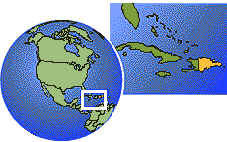
Dominican Republic

Dominican Republic (Spanish República Dominicana), republic of the West Indies, comprising the eastern two-thirds of the island of Hispaniola. The country is bounded on the north by the Atlantic Ocean; on the east by the Mona Passage, which separates it from Puerto Rico; on the south by the Caribbean Sea; and on the west by Haiti. The Dominican Republic has an extreme length in an east to west direction of about 380 km (about 235 mi) and a maximum width, in the west, of about 265 km (about 165 mi). The frontier with Haiti is some 315 km (some 195 mi) long. The area is 48,734 sq km (18,816 sq mi). A number of adjacent islands, among them Beata and Saona, are possessions of the Dominican Republic. Santo Domingo is the capital of the Dominican Republic as well as its largest city.
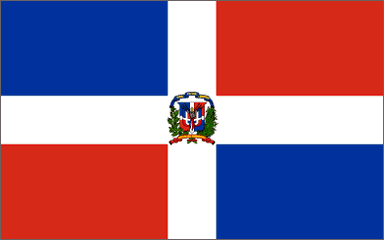
Land and Resources
The Dominican Republic is a fertile, well-watered, mountainous country. About 80 percent of the country is covered with a series of massive mountain ranges, extending in a northwestern to southeastern direction. Pico Duarte (3175 m/10,417 ft) is the highest mountain in the country and in the West Indies. Between the Cordillera Central and the Cordillera Septentrional, a parallel range to the north, is the Cibao Valley, one of the most fertile and best-watered areas of the country. The coastal plain in the southeast is another fertile region. Among the numerous streams of the Dominican Republic are the Yaque del Norte, Yuna, and Camú rivers in the north and the Yaque del Sur, Ozama, and Soco rivers in the south.
The principal lake is the saltwater Lake Enriquillo, about 43 km (about 27 mi) long, situated in the southwest. The coastline of the Dominican Republic, about 1633 km (about 1015 mi) in length, is irregular and indented by many bays forming natural harbors, notably Ocoa Bay in the south and the Bay of Samaná in the northeast.
Climate
The Dominican Republic has a semitropical climate, tempered by the prevailing easterly winds. Temperatures of more than 23.3° C (more than 74° F) are registered in the lowlands throughout the year. During the summer months temperatures range between 26.7° and 35° C (80° and 95° F) in these regions. The highlands are considerably cooler. Annual precipitation averages about 1525 mm (about 60 in), but considerably more moisture is received by the mountainous areas of the north. The wet season is from June to November. Tropical hurricanes occur occasionally; Hurricane David, which struck in 1979, caused great damage.
Natural Resources
The main resources of the Dominican Republic are agricultural. The fertile soil in the valleys is conducive to farming, and many of the mountain slopes are covered with forests. The country also has valuable deposits of nickel, gold, and silver.
Plants and Animals
The vegetation of the Dominican Republic, like that of the other islands of the West Indies, is extremely varied and luxuriant. Among the species of indigenous trees are mahogany, rosewood, satinwood, cypress, pine, oak, and cacao. Many species of useful plants and fruits are common, including rice, tobacco, cotton, sugarcane, yam, banana, pineapple, mango, fig, grape, and breadfruit.
The most noteworthy mammal among the indigenous animals is the agouti, a rodent. Wild dogs, hogs, and cattle are abundant, as are numerous reptiles, notably snakes, lizards, and caimans. Waterfowl and pigeons are common birds.
Population
Most of the population of the Dominican Republic is of mixed Spanish and black-African descent. The society is about 65 percent urban.
Population Characteristics
The population of the Dominican Republic (1995 estimate) is about 7,915,000, giving the country an overall population density of about 162 persons per sq km (about 421 per sq mi).
Political Divisions and Principal Cities
The Dominican Republic is divided into 29 provinces plus the Distrito Nacional (National District), which encompasses Santo Domingo, the capital. The provinces are subdivided into municipalities and townships.
Santo Domingo, also the leading port, had an estimated population of 2,400,000 in 1994. Other important cities include Santiago or Santiago de los Caballeros (1994; 500,000), a trade and transportation center; San Pedro de Macorís (1991 estimate; 137,000), a seaport; and San Francisco de Macorís (1991 estimate; 162,000) and Barahona (1981; 49,334), both agricultural trade centers.
Language and Religion
Spanish is the official language of the Dominican Republic. English is also spoken, and a French dialect is heard along the Haitian frontier. The great majority of the people profess Roman Catholicism. There is a small Protestant community, and about 1 percent are Spiritists.
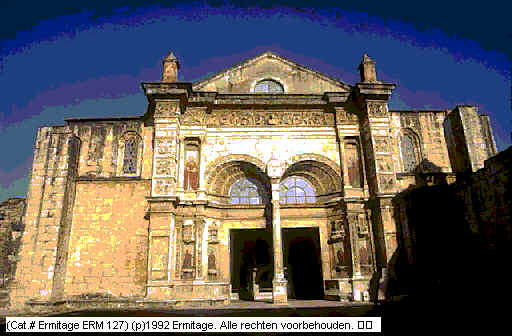
The oldest existing settlement founded by Europeans in the western hemisphere, Santo Domingo, the capital and largest city of the Dominican Republic, boasts many historical attractions. The Cathedral of Santa Maria la Menor, constructed during the early 1500s, is the oldest church in the West Indies. Some historians believe that the remains of famed navigator Christopher Columbus rest in the cathedral.
Tom Bean/ALLSTOCK, INC.
Education
The Dominican Republic provides free, compulsory education to children between the ages of 7 and 14. About 83 percent of the population aged 15 or older is literate. In the late 1980s approximately 1.3 million pupils attended primary schools each year. Students in secondary schools numbered about 451,700, including those attending vocational schools and institutions for teacher training.
The Autonomous University of Santo Domingo, founded in 1538, is the oldest in the western hemisphere. Other universities include Pedro Henríquez Ureña National University (1966) in Santo Domingo, and institutions in Santiago, San Pedro de Macorís, and San Francisco de Macorís. The yearly enrollment in schools of higher education exceeded 80,000 in the late 1980s.
Culture
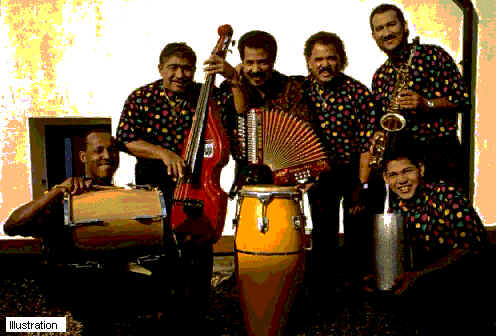
The merging of the plena (African-derived work songs) and the decima (a 10-line, 17th-century Spanish verse song form) has created a highly original and sophisticated song tradition in the Dominican Republic. The dance form associated with this music is the merengue, which synthesizes European and Afro-Caribbean rhythms. In the Dominican Republic the merengue was originally a couple dance related to European line dances. The dance form has since become popular throughout Latin America.
Dave Peabody/ACE Records/"Arturo Pa Monte"(F. Ulloa) from Francisco Ulloa: Ultramerengue (Cat.# CDORBD 080) (p) 1992 Globestyle/ACE Records, Ltd. All rights reserved.
The first permanent colony of Europeans in the western hemishere was established in the Dominican Republic, and Western traditions have been a strong presence ever since. Some of the old colonial buildings are still standing, fine examples of which are in Santo Domingo. Art, music, and literature are developed in part on Western patterns. Almost equally strong is the African cultural strain. In the folk culture, especially the music, the African heritage is most noticeable. These two traditions blend in the popular national song and dance, the merengue. Most of the country’s major cultural institutions, including the National Fine Arts Gallery, are in Santo Domingo.
Economy
The economy of the Dominican Republic is predominantly agricultural, and nearly half of the workforce is employed in farming. The country also has an important mining sector. In the early 1990s the estimated national budget included about $865 million in revenues and about $784 million in expenditures.
Agriculture
The principal cash crops of the Dominican Republic are raised on large plantations. Most farmers, however, engage in subsistence cultivation. Sugarcane is the main cash crop; the largest plantations are in the southeast. In the early 1990s about 6.8 million metric tons of sugarcane were produced. Other important crops were rice (446,000 metric tons), bananas (389,000), coffee (55,000), cacao (44,000), and tobacco (24,000). Cattle, hogs, and poultry are raised primarily for local consumption.
Forestry and Fishing
About 13 percent of the land of the Dominican Republic is forested. The government fosters conservation and has regulated the forest industry since the early 1960s. The main woods cut are mahogany, satinwood, pine, and cedar. The fishing industry is underdeveloped, mainly because of a lack of deep-sea fishing equipment and refrigeration facilities. The catch, which includes mackerel, tuna, bonito, and snapper, totaled about 17,200 metric tons annually in the early 1990s.
Mining
Production of bauxite, formerly the Dominican Republic’s dominant mineral export, virtually ended in the early 1980s. Mineral products in the early 1990s included 75,797 metric tons of ferronickel, 101,606 troy oz of gold, and 705,864 million troy oz of silver.
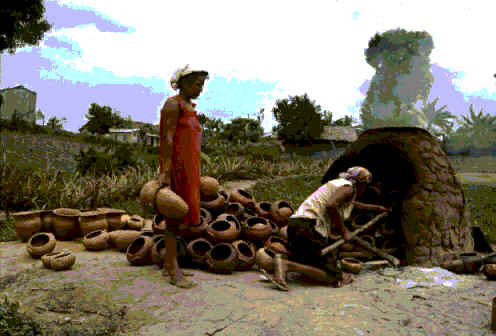
The Dominican Republic, a republic of the West Indies, is rich in gold, silver, nickel, and bauxite deposits. The country also has clay deposits, used to make bowls and other pottery items. The pottery is formed by hand and then is baked in outdoor kilns such as the one shown here.
Nancy D. McKenna/Photo Researchers, Inc.
Manufacturing
Sugar refining is a leading industrial activity in the Dominican Republic; output of refined sugar in the early 1990s was about 93,500 metric tons. Also produced were textiles, cement, cigars, cigarettes, fertilizer, molasses, refined petroleum, and processed wheat and rice.
Energy
Almost all the Dominican Republic’s electricity is produced in thermal plants. In the early 1990s the country had an installed electricity-generating capacity of some 2.3 million kilowatts, and annual production was about 5 billion kilowatt-hours.
Currency and Banking
The unit of currency in the Dominican Republic is the peso (13.76 pesos equal U.S.$1; 1995). The republic has several commercial banks; one, the Banco de Reservas, is government controlled. The Central Bank of the Dominican Republic is the sole bank of issue.
Foreign Trade
The principal exports of the Dominican Republic typically are sugar, ferronickel, gold, coffee, cocoa, and tobacco. Sugar and sugar products usually make up more than one-third of all export earnings. Machinery, iron and steel, foodstuffs, petroleum and petroleum products, and chemicals are leading imports. In the early 1990s the total value of exports was about $735 million per year and of imports about $1.8 billion. The United States is the leading trade partner of the Dominican Republic, followed by Venezuela, Mexico, and Japan.In 1995 the Dominican Republic joined the Association of Caribbean States (ACS), a free trade group. The ACS is composed of the members of the Caribbean Community and Common Market (CARICOM) and 12 nations bordering the Caribbean.
Transportation
The road system of the Dominican Republic totalled about 17,000 km (12,000 mi) in the early 1990s, of which 48 percent is paved. Most of the 1650 km (1025 mi) of railroad in use is privately owned and serves the sugar plantations. Aside from the Santo Domingo port, other large ports are located at Puerto Plata in the north and Barahona in the southwest. The country is served by several international and domestic airlines.
Communications
The Dominican Republic has more than 90 commercial radio stations and some 1,180,000 radios. In addition, the country has several television broadcasters and about 556,000 television sets. Some 12 daily newspapers, with a combined daily circulation of about 270,000, are published; El Caribe and Listín Diario, both issued in Santo Domingo, are influential. Some 300,000 telephones are in use.
Labor
The wage labor force of the Dominican Republic exceeded 2.3 million workers in the early 1990s. An estimated 49 percent of all Dominican workers engaged in agriculture, 18 percent in industry, and 33 percent in services. The Confederación de Trabajadores Dominicanos, and the Unión General de Trabajadores Dominicanos, two of the nation’s leading labor unions, merged in 1988.
Government
The Dominican Republic is governed under a constitution promulgated in 1966.
Central Government
Executive power in the Dominican Republic is vested in a president, who is popularly elected for a term of four years. The president appoints a cabinet and may also introduce bills in congress.
Legislature
The bicameral congress of the Dominican Republic is composed of an upper chamber (the Senate), which has 30 members, and a lower chamber (the Chamber of Deputies), with 120 deputies. All legislative members are popularly elected for terms of four years.
Judiciary
The highest tribunal in the Dominican Republic is the Supreme Court of Justice, made up of a president and eight judges, all of whom are appointed by the Senate, and a procurator-general, appointed by the president. Lower courts include courts of first instance and courts of appeal.
Political Parties
The Dominican Party was the only legal party between 1930 and 1961, when it was dissolved and new parties were established. The principal parties in the late 1980s were the Partido Reformista Social Cristiano (PRSC), the Partido de la Liberacíon Dominicana (PLD), and the Partido Revolucionario Dominicano (PRD). The PRSC draws support from the peasant and middle classes, the PLD was formed by breakaway members of the PRD, and the PRD is composed largely of landless peasants and urban workers.
Local Government
The 29 provinces of the Dominican Republic are administered by governors, who are appointed by the country’s president. Each municipality and the Distrito Nacional elect a mayor and a municipal council as the administrative body.
Health and Welfare
In 1964 the government of the Dominican Republic inaugurated a program aimed at raising health standards. Drainage systems, garbage disposal plants, and aqueducts were built in all of the larger cities. Several government agencies were established for the purpose of increasing water facilities in rural and urban areas.
Government programs provide some health services, but the republic has no comprehensive system for welfare. The country had more than 3100 physicians in the mid-1980s.
Defense
In the early 1990s the armed forces of the Dominican Republic comprised an army of about 15,000, a navy of about 4000, and an air force of about 4200. Military service is voluntary.
History
The aboriginal inhabitants of Hispaniola were Arawak people, engaged principally in farming and fishing. They eventually became extinct as a result of exploitation by Spanish colonists. Black slaves were later imported to take the place of the Arawak laborers. In time the Spanish migrated from Hispaniola to South America, and for about a century the island was sparsely populated. In 1697, by the Peace of Ryswick, the portion of Hispaniola that had been occupied by French adventurers was formally ceded to France and became known as Saint-Domingue; it is now Haiti. The remaining Spanish section, what is now the Dominican Republic, was called Santo Domingo.
Shifting Sovereignties
The French in their part developed a flourishing plantation economy and a lively trade, while the Spanish area, bypassed by commerce and shown little interest by the administrative authorities, declined; many people left, and much of the land remained unpopulated. Spain finally ceded Santo Domingo to France in 1795. During the years that followed, the country was caught up in the convulsions of neighboring nascent Haiti, fought over by the French, Spanish, and English, as well as indigenous mixed-race and black people. When Haiti ousted the French in 1804, Santo Domingo remained under French occupation for another five years. Then the French were expelled and nominal Spanish rule restored. After 1814, however, the Spanish administration became increasingly tyrannical, and in 1821 the Dominicans rose in revolt, proclaiming their independence. It was short-lived. The following year Haitian President Jean Pierre Boyer led his troops into the country and annexed it to Haiti, thus bringing the entire island under his control. Boyer ruled until overthrown by a revolution in 1844. A year later Santo Domingo again declared its independence, forming the Dominican Republic.
A Period of Strife
The first president was Pedro Santana, who served for three terms between 1844 and 1861. Both his administrations and the subsequent ones were characterized by popular unrest and frequent boundary disputes with Haiti. The internal strife was most clearly discernible in the two political groups that took root within the republic: One faction advocated return to Spanish rule and the other, annexation to the United States. For a brief period, from 1861 to 1863, the country, led by former President Santana, did return to Spanish rule, but a popular revolt between 1863 and 1864 and subsequent military reverses and U.S. intervention forced the Spanish government to withdraw its forces and to annul the annexation. The second Dominican Republic was proclaimed in February 1865. Political turmoil continued, however, through the rest of the 19th century.
Because of Dominican indebtedness to a number of European nations, some of which threatened intervention, the Dominican government signed a 50-year treaty with the United States in 1906, turning over to the United States the administration and control of its customs department. In exchange the United States undertook to adjust the foreign financial obligations of the Dominican government. Internal disorders during the ensuing decade finally culminated in the establishment of a military government by the U.S. Marines, who occupied the country on November 29, 1916. Control of the country was, however, gradually restored to the people, and by March 1924 a constitutional government had assumed control. Later that year the American occupation ended.
The Trujillo Era
The outstanding political development of the subsequent period was the dictatorship established by General Rafael Leonidas Trujillo Molina. Elected to the presidency in 1930, Trujillo forcibly eliminated all opposition, thereby acquiring absolute control of the nation. For the next 31 years, although he personally occupied the presidency only half that time (from 1930 to 1938 and again from 1943 to 1952), Trujillo presided over one of the tightest dictatorships in the world. With the military as the basis of his power, he and his family directed practically every aspect of the nation’s life, from the courts down to the pettiest bureaucrat. The national economy, while greatly expanded and modernized, was run as the dictator’s personal corporation, and the political process was completely dominated by his Dominican Party. Backed at first by the United States, Trujillo used this support to his own advantage in shoring up his power. Discontent and criticism, widespread especially after World War II ended in 1945, were met with terror and self-serving propaganda.
During Trujillo’s rise to power, however, considerable material progress was made. Many new hospitals and housing projects were finished, a pension plan was established, and public health facilities, harbors, and roads were improved. A boundary dispute with neighboring Haiti, going back to 1844, was settled in 1935, and in 1941 the U.S. government terminated the administration of the Dominican customs. In December 1941, shortly after the United States entered World War II, the Dominican Republic also declared war on Japan, Germany, and Italy. It subsequently became a charter member of the United Nations. In 1948 the country also became a charter member of the Organization of American States (OAS), which in subsequent years frequently condemned the Trujillo regime both for interference in the internal affairs of neighboring countries and "flagrant and widespread violations of human rights." OAS criticism culminated in 1960 in a resolution calling for severance of diplomatic relations with the Dominican Republic; the United States did so shortly afterward. These external pressures were coupled with growing internal resistance to the regime. The Trujillo era ended with the dictator’s assassination on May 26, 1961.
Democracy Restored—and Toppled
After the assassination, agitation mounted against the continued political dominance of the Trujillo family. Numerous exiles began to return home and political parties were reestablished. In October 1961 the two brothers of the late dictator left the country, but they returned in November, apparently with the intention of seizing governmental power. President Joaquín Balaguer, who had assumed the office as a Trujillo puppet in 1960, reacted to the threat by assuming control of the armed forces. To demonstrate support of Balaguer, the United States stationed warships and planes off the Dominican coast. The show of force speedily induced all members of the Trujillo family to leave the country. Opposition groups, however, rallied against Balaguer; after a wave of strikes and demonstrations, he and his opponents agreed on a plan under which he would retain the presidency until sanctions, imposed by the OAS since 1960, were lifted. The sanctions were revoked in January 1962, and shortly afterward Rafael Bonnelly, an opponent of Balaguer, was designated president to serve until elections were held.
In December 1962 the Dominican Republic held its first free election in nearly four decades. Juan Bosch, a returned exile, won by a wide margin and was inaugurated on February 27, 1963. Almost immediately, opposition to his regime began to develop. Bosch was criticized as being too tolerant of pro-Castro (see Fidel Castro) and Communist groups, and the business community felt threatened by changes in the country’s economic policy. On September 25 Bosch was deposed by a military coup and the leaders installed a three-man civilian junta. To indicate disapproval of the coup, the United States withheld recognition until the new regime promised to hold elections by 1965.
The United States Intervenes
Throughout 1964 restlessness within the country was manifested by strikes and sabotage and by conflicts within the junta. On April 24, 1965, a group within the army rebelled against the government with the avowed purpose of restoring Bosch as president. Air force and navy elements opposed the insurgents, and Santo Domingo became the battleground of a civil war. Four days later, a contingent of U.S. Marines was landed in Santo Domingo to protect U.S. interests. The U.S. forces took up positions in a so-called international zone, which served as a barrier between the rebel-occupied area of the city and the sections occupied by the junta loyalists. From his exile in Puerto Rico, Bosch accused rightists of provoking intervention by the United States, which, he said, had prevented a rebel victory. He denied charges by the United States of Communist takeover of the rebel cause. In early May the OAS arranged a cease-fire and established an inter-American military force for peacekeeping duties. The OAS forces began arriving in mid-May, and in June U.S. Marines were withdrawn from the country; 12,500 other U.S. troops, however, remained.
The Balaguer Government
During the summer the OAS tried to arrange a settlement between the loyalists and the rebels (who called themselves "constitutionalists" to indicate their desire to restore the constitutionally elected government of Bosch). At the end of August the two factions agreed to establish a provisional government, and a few days later Hector García-Godoy, former foreign minister under Bosch, assumed the presidency. Subsequently, Bosch, Balaguer, and Bonnelly all announced their candidacies in the presidential election scheduled for June 1966. In the election, Balaguer, a conservative, won with 56 percent of the vote. Under his administration, although not completely democratic, relative stability was restored to the country. The economy showed strength, aided by high sugar prices, foreign investment, and increased tourism, enabling Balaguer to win reelection easily in 1970 and 1974. The Partido Revolucionario Dominicano (PRD), led by Bosch, boycotted both elections, charging restrictions on its campaign activities.
The PRD Wins Power
In the mid-1970s a sharp decline in world sugar prices adversely affected the Dominican economy, and Balaguer’s support began to dwindle; in the 1978 elections he was turned out of office, defeated by the PRD candidate, Silvestre Antonio Guzmán. After foiling a plot by right-wing military men to prevent him from taking office, Guzmán purged the armed forces of many Balaguer supporters, released some 200 political prisoners of the previous regime, and eased press censorship. The economy remained troubled by low sugar prices and was further damaged by two hurricanes in 1979 that left more than 200,000 people homeless and caused $1 billion in damages.
Guzmán chose not to run again in 1982. He died in July of that year, an apparent suicide, shortly after Senator Salvador Jorge Blanco was elected to succeed him. To rescue the country from its deepening economic crisis, Jorge Blanco turned to the International Monetary Fund, which demanded austerity measures in exchange for a three-year loan package. These measures, including price increases for basic foods and gasoline, led to protest riots throughout the nation in 1984 and 1985. Balaguer was returned as president in 1986. In 1988, Jorge Blanco was tried in absentia and found guilty of corruption during his presidential years. In the 1990 presidential election, Balaguer defeated Bosch by a narrow margin. He was reelected in 1994 but agreed to serve only a two-year term after he was accused of electorial fraud. In a presidential runoff election held in June 1996 Leonel Fernández Reyna of the Dominican Liberation Party (PLD) defeated José Francisco Peña Gómez of the PRD to win the presidency of the Dominican Republic.